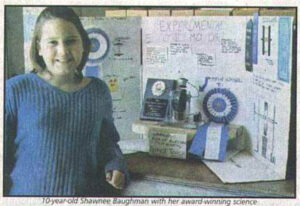Tesla’s Technology Miniaturized And Simplified For The Masses
Legacy of a World-Class Inventor & Humanitarian
Spokane, Washington – November 2, 2014
Fifteen years ago, Shawnee Baughman of Coeur d’Alene, Idaho was competing for an elementary school science project and an electronics wizard happened to work in the same building as her father. She was provided with a simple schematic and a bit of coaching. With that, she went off on her own to build a little motor that spun a wheel, lit an LED light, and ran from the same 9 volt battery for the entire five days of the science fair.
 Shawnee won a Blue Ribbon for the science, and a special award for Best of Show, and ever since that time, the machine has been called the “School Girl Motor” or the “Bedini SG” for short.
Shawnee won a Blue Ribbon for the science, and a special award for Best of Show, and ever since that time, the machine has been called the “School Girl Motor” or the “Bedini SG” for short.
John Bedini is an internationally acclaimed audio engineer who has many claims to fame, which include developing the first solid state audio amplifiers that actually replicated the sound qualities of the old vacuum tube models. But his favorite hobby has always been the study of advanced energy conservation methods using unconventional electromagnetic principles that most engineers have never heard of.
The Bedini SG has since taken the world by storm, spreading far and wide across the internet, and allowing countless thousands of people to build their own model and study the physics involved. Just about anybody can get one to spin, but only a handful have ever achieved a level of performance that demonstrates what some would consider “free energy.”
Many experts claim this is impossible, but actually there are many systems that produce more work than we’re required to supply, because the excess energy is provided by the environment. A good example of this is the refrigerator. This ordinary kitchen appliance typically operates with a “coefficient of performance” of 2.0, which means that twice as much heat is removed from inside than the equivalent electricity used to do it. Most scientist believe that this kind of performance is only possible with heat systems, but John Bedini and others have demonstrated these principles with electromagnetics as well.
In 1977, Ilya Prigogine received a Nobel Prize for what is basically an extension to conventional thermodynamics, which only describe how heat operates in “closed systems.” Those are systems that are cut off from any external form of energy. Prigogine’s work helped to extend our understanding of thermodynamics to include systems that are open to the environment, which slows the appearance of entropy down and allows more total work to be done than what we have to supply. That is exactly what the Bedini SG demonstrates in a simple and most elegant way.
Several years ago, A & P Electronic Media, a digital publishing company founded by Aaron Murakami and Peter Lindemann published the first ever authoritative book on Bedini’s technology. Murakami and Lindemann have collectively known John Bedini for over 45 years and both have been personally mentored by him.
Their first book outlining the basics of this technology is Bedini SG – The Complete Beginner’s Handbook, which includes all of Bedini’s own personal specifications for building his machines, as well as an in depth explanation of the science and theory behind its operation. With this book, just about anyone can build a working model.
The second book is Bedini SG – The Complete Intermediate Handbook. It digs deeper into the theory of the technology and shows how John’s circuits act like miniaturizations of systems developed by Nikola Tesla over 120 years ago. What this process does is take the high voltage spikes from an electromagnetic oscillator and charge a capacitor with them. This capacitor is then discharged into a load, such as a lead acid battery.
Engineers are normally taught to ground these spikes out so they don’t damage other electronics on an electrical line. In fact, that is what a “surge protector” is designed to do. Through experimentation, John discovered that these electrical transients have a number of unusual characteristics. One of these benefits includes the ability to charge batteries extremely efficiently, and even revive some batteries that are considered dead.
Although many engineers claim these spikes can’t charge a battery because they are just high voltage with virtually no current, there are thousands upon thousands of global experiments being conducted with these circuits that prove otherwise. And if these spikes are used to charge a capacitor and then that capacitor is discharged into a battery, even more amazing results can be had. And this is one of the methods for using electricity that Nikola Tesla developed back in 1893. John’s circuits are literally a miniaturized version of some of Tesla’s greatest discoveries.
 A & P Electronic Media has now released Bedini SG – The Complete Advanced Handbook. The finale to this paradigm-shattering trilogy teaches the reader how to convert the mechanical work produced on the wheel into even more electricity, in an extremely efficient way. As a matter of fact, it is so efficient that at the recent 2014 Energy Science & Technology Conference, Peter Lindemann was able to demonstrate how to light a large bank of LEDs to a very bright level without reflecting almost any mechanical load back to the machine.
A & P Electronic Media has now released Bedini SG – The Complete Advanced Handbook. The finale to this paradigm-shattering trilogy teaches the reader how to convert the mechanical work produced on the wheel into even more electricity, in an extremely efficient way. As a matter of fact, it is so efficient that at the recent 2014 Energy Science & Technology Conference, Peter Lindemann was able to demonstrate how to light a large bank of LEDs to a very bright level without reflecting almost any mechanical load back to the machine.
This third book also reveals many details from John Bedini’s other related technologies, some of which have never been released or explained to the public before. In that sense, it also doubles as a tribute to his tireless contribution to the field of advanced energy research over the last four decades.
Learn more about this amazing trilogy here: https://emediapress.com/shop/bedini-sg/



